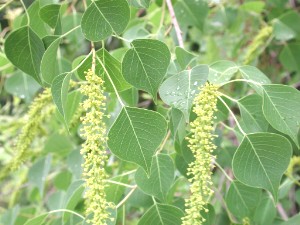
Triadica sebifera is a tree native to eastern China. It is commonly called Chinese tallow, Chinese tallowtree, Florida aspen, chicken tree, gray popcorn tree, or candleberry tree.

Vachellia farnesiana, also known as Acacia farnesiana, and previously Mimosa farnesiana, commonly known as sweet acacia, huisache, or needle bush, is a species of shrub or small tree in the legume family, Fabaceae. Its flowers are used in the perfume industry.
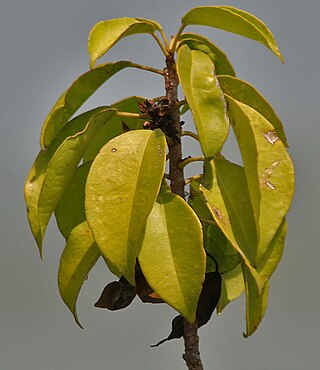
Excoecaria is a plant genus of the family Euphorbiaceae, formally described by Linnaeus in 1759. The genus is native to the Old World Tropics.

Brachychiton acerifolius is a large tree of the family Malvaceae endemic to tropical and subtropical regions on the east coast of Australia. It is famous for the bright red bell-shaped flowers that often cover the whole tree when it is leafless. It is commonly known as the flame tree, Illawarra flame tree, lacebark tree, or kurrajong.
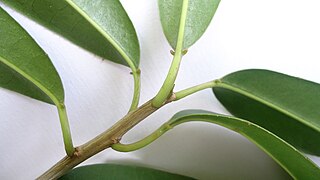
Sapium glandulosum is a species of tree in the family Euphorbiaceae. It is native to the Neotropics from Mexico and the Caribbean south to Argentina, and it has been cultivated elsewhere. It is the most common Sapium species. Its common names include gumtree, milktree, leche de olivo, and olivo macho.

Dichrostachys cinerea, known as sicklebush, Bell mimosa, Chinese lantern tree or Kalahari Christmas tree, is a legume of the genus Dichrostachys in the family Fabaceae.
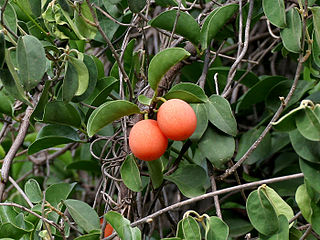
Ximenia americana, commonly known as tallow wood, hog plum, yellow plum, sea lemon, or pi'ut (Chamorro), is bush-forming shrub/small tree; a species from the Ximenia genus in the Olacaceae family. It is mainly found in the tropics, ranging from Africa, India and southeast Asia, to Australia, New Zealand, Pacific Islands, West Indies, Central, North and South America. It is especially common in Africa and South America. It is not domesticated so it is only found occurring in the wild.
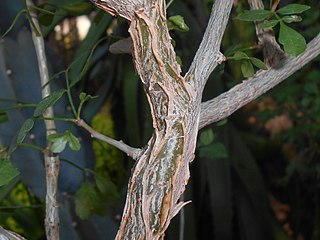
Commiphora habessinica, sometimes known as Abyssinian myrrh or the Yemen myrrh, is a plant native to northeast Africa and the Arabian peninsula, including Djibouti, Eritrea, Ethiopia, Zambia, Malawi, Oman and Yemen. It was first described by Otto Karl Berg in 1862 as Balsamodendrum habessinicum from northeast Africa. It was then transferred to the genus Commiphora by Adolf Engler in 1883, but given the name Commiphora abyssinica, an orthographical variant. It can be recognised by its simple, serrate leaves and by the pseudo aril, covering the seed, which has four almost linear arm-like lobes.

Lumnitzera racemosa, commonly known as the white-flowered black mangrove, is a species of mangrove in the family Combretaceae. It is found on the eastern coast of Africa and other places in the western Indo-Pacific region. It has one accepted variety from the noniminate species, Lumnitzera racemosa var. lutea (Gaudich.) Exell.

Stillingia lineata is a species of flowering plant in the family Euphorbiaceae, native to Réunion, Mauritius, the South China Sea, Malesia and Fiji.
Excoecaria bussei is a species of flowering plant in the family Euphorbiaceae. It was originally described as Sapium busseiPax in 1903. It is native from Kenya to the Caprivi Strip.
Stillingia bodenbenderi is a species of flowering plant in the family Euphorbiaceae. It was originally described by Otto Kuntze as Sapium bodenbenderi in 1898. It is native to southeastern Brazil and northeastern Argentina.
Stillingia salpingadenia is a species of flowering plant in the family Euphorbiaceae. It is native to northeast Argentina, Bolivia, west-central Brazil, and Paraguay.
Stillingia tenella is a species of flowering plant in the spurge family, Euphorbiaceae. It was originally described as Sapium tenellumPax & K.Hoffm. in 1924. It is native to Bolivia and northwest Argentina.
Stillingia zelayensis is a species of flowering plant in the family Euphorbiaceae. It was originally described as Sapium zelayenseKunth in 1817. It is native to Central America.
Excoecaria cuspidata is a species of flowering plant in the family Euphorbiaceae. It was originally described as Excoecaria hialayensis var. cuspidataMüll.Arg. It is native to China and Meghalaya, India.
Excoecaria formosana is a species of flowering plant in the family Euphorbiaceae. It was originally described as Excoecaria crenulata var. formosanaHayata. It is native to Nansei-shoto, Japan and Taiwan.
Excoecaria goudotiana is a species of flowering plant in the family Euphorbiaceae. It was originally described as Stillingia goudotianaBaill. in 1861. It is native to Madagascar.
Excoecaria guineensis is a species of flowering plant in the family Euphorbiaceae. It was originally described as Stillingia guineensisBenth. in 1849. It is native to western and central tropical Africa.
Triadica cochinchinensis is a species of tree known as the mountain tallow tree.










